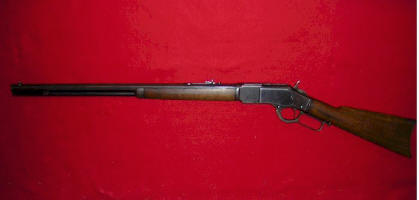 |
|

Introduction | I. History of Winchester Rifles | II. Models | III. Styles | IV. Outline of Features | V. Condition | VI. Diagrams
Step 1: Determine the Model of firearm
The standard 1876 rifle was a lever action and had a walnut stock, with a crescent buttplate and trap-door. There are 3 Model Configurations with primarily serial numbers and the dust cover type separating those models.
Remember that many different options were available directly from the Winchester factory, and you can find deluxe varieties in the 1876 that have checkered stocks and for the first time may have a pistol grip, shortened magazine and/or other added features. If your gun has any of these features, you should contact a certified appraiser.
Serial Number is the major criteria that will be used to differentiate among the 3 different Model Configurations of the 1876 Winchester. The serial number is found on the lower tang just past the finger-lever handle.
For the Style of rifle that you have (Determined in Step #2), note that barrel length is measured from the end of the barrel tip (past the front sight), to the end of the barrel threads (beyond where the barrel inserts into the receiver in the middle of the gun). In the 1876 Winchester, you can measure from the top of the receiver from where the bolt opening ends, to the barrel tip, to get an accurate overall barrel length. As an example, in the Carbine (pictured below), which has a 20" barrel, the measurement from the barrel tip to the receiver front is only 19 1/4 ". In order to add the distance of the barrel threads, you need to keep measuring into the receiver until you reach the end of the threads at the bolt/receiver opening (see where arrow points to in picture below). This will give you the correct barrel length measurement of 20".
| --> |
Use the following Key to determine which model of gun you have. Start at "a" and then select one of the "a" choices. Follow the STEPS through the key to determine your rifle type. Then confirm with the overall descriptions and variations. These guns were very popular and some have gone through many hands. Each owner had an opportunity to modify the gun, add parts, change parts, and remove features. Be alert for such modifications, and remember that any modification from the original probably decreases value.
If you need help determining names used for the parts of your gun, examine the Parts Diagram by Clicking Here.
Easy Key:
a. My gun is a lever action with a Serial Number that is
EQUAL TO OR GREATER THAN 3,000 .
---
Go to section b
a. My gun is a lever action with a Serial Number LESS THAN 3,000.
You have a FIRST MODEL.
|
Enter the Model of your gun in the column to the right |
|
b. My gun has a Serial Number that GREATER THAN 30,000 --- Go to section c
Winchester with Serial Number greater than 30,000
b. My gun is a lever action with a Serial Number THAT IS LESS THAN 30,000. You have a SECOND MODEL 1876 Winchester.
|
1876 Caliber Marking on bottom of receiver |
Late 2nd Model dust Cover |
|
Enter the Model of your gun in the column to the right |
|
c. My gun has a SERIAL NUMBER GREATER THAN 30,000. You have a THIRD MODEL 1876 Winchester.
|
Enter the Model of your gun in the column to the right |
|
c. My gun is a Model 1876 saddle-ring carbine with a 22" round barrel, and .45-70 WCF caliber. The stock is plain walnut with a straight grip, and the forearm is plain and almost to the end of the barrel. The butt plate is metal carbine style. The rear sight is a folding-ladder type and is calibrated in METERS. You have a Winchester 1876 Rifle made for the Northwest Mounted Police.
|
Enter the Model of your gun in the column to the right |
|
Once you have determined the model, you might want to visit the Outline of Features page to see the standard features of the Model 1876. This will help you to determine if modifications might have been made to the original condition of your gun.
You have now completed STEP #1 of this Appraisal. Be sure that you have marked off in the box at the right for the appropriate model of 1876 that you have
Continue to Step 2 and the styles of Model 1876s
Introduction | I. History of Winchester Rifles | II. Models | III. Styles | IV. Outline of Features | V. Condition | VI. Diagrams